
The Tortricidae are a family of moths, commonly known as tortrix moths or leafroller moths, in the order Lepidoptera. This large family has over 11,000 species described, and is the sole member of the superfamily Tortricoidea, although the genus Heliocosma is sometimes placed within this superfamily. Many of these are economically important pests. Olethreutidae is a junior synonym. The typical resting posture is with the wings folded back, producing a rather rounded profile.

The Archipini are a tribe of tortrix moths. Since many genera of these are not yet assigned to tribes, the genus list presented here is provisional.

Parienia is a genus of moths belonging to the subfamily Olethreutinae of the family Tortricidae. This genus was described by Edward Meyrick in 1881. It consists of only one species, Parienia mochlophorana, which is endemic to New Zealand.
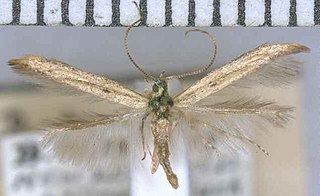
Batrachedra arenosella, the armoured scale eating caterpillar or the coconut moth, is a species of moth of the family Batrachedridae. It was first described by Francis Walker using specimens collected in Auckland, New Zealand. It has been hypothesised that the New Zealand moth may contain two distinct species. As well as the moth species in New Zealand, this name has been applied, perhaps incorrectly, to moths found in India, Indonesia, the Malay Peninsula, and Réunion, as well as in Australia, from the Northern Territory and northern Queensland to New South Wales and South Australia.
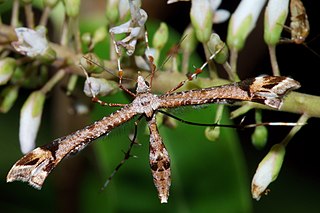
Amblyptilia falcatalis, the common Hebe plume moth, is a species of moth of the family Pterophoridae. This species was first described by Francis Walker and is endemic to New Zealand. This species can be found in both the North and South Islands. The larval host plants are in the Veronica genus and include Veronica stricta,Veronica salicifolia,Veronica elliptica, Veronica macrocarpa and Veronica speciosa. This moth likely has two broods a year and adults have been observed all year round.

Heterocrossa sanctimonea is a moth of the Carposinidae family first described by Charles E. Clarke in 1926. It is endemic to New Zealand.

The parsnip moth or parsnip webworm is a moth of the family Depressariidae. It is found in most of Europe, except Portugal and most of the Balkan Peninsula. This species has also been introduced into New Zealand.

Asaphodes aegrota is a species of moth in the family Geometridae. It was first described by Arthur Gardiner Butler in 1879 as Selidosema aegrota. It is endemic to New Zealand and can be found in the North, South and Stewart Islands. This species inhabits open spaces in lowland native forest. The larvae of A. aegrota feed on native herbs and have also been observed feeding of the introduced lawn daisy. The adults are variable in appearance with the markings on both sides of its wings varying in intensity. Some populations also have narrow winged females. Adults are on the wing from November until March.

Planotortrix flammea is a species of moth of the family Tortricidae. It is endemic to New Zealand.

Planotortrix notophaea, the blacklegged leafroller, is a species of moth in the family Tortricidae. It is endemic to New Zealand. It was also present near Sydney in Australia, but this population is thought to be extinct.
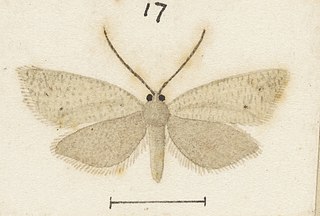
Ericodesma aerodana is a species of moth of the family Tortricidae. It is endemic to New Zealand and is found in the North and South Islands. The species inhabits sand dunes and larvae feed on Pimelea prostrata. Adults are on the wing from October to January and are active at twilight. This species is classified as "At Risk, Declining" by the Department of Conservation as its larval host plant is under threat from habitat loss and the invasive to New Zealand plant, sea spurge.

Aristotelia paradesma is a moth of the family Gelechiidae. It was described by Edward Meyrick in 1885 and is endemic to New Zealand. This species has been observed on both the North and South Islands. The larvae feed on Coprosma species creating and living in stem galls. The adults are on the wing from November to March and are attracted to light.
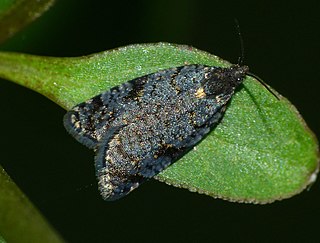
Tortrix molybditis is a species of moth of the family Tortricidae. It is endemic to New Zealand. It is likely that this species probably belongs to another genus and as such this species is also known as Tortrix (s.l.) molybditis.

Tingena nycteris is a species of moth in the family Oecophoridae. It is endemic to New Zealand and has been observed in the North and South Islands. This species inhabits native forest and scrubland and adults are on the wing from October to January.

Stenoperla prasina is a species of stonefly belonging to the family Eustheniidae. This species is endemic to New Zealand and is classified as "Not Threatened" under the New Zealand Threat Classification System. It is found on the North, South and Stewart Island / Rakiura Islands as well as on Little Barrier Island. Although adults of this species are most often coloured bright green, this species can be coloured yellow. This species inhabits clean, cold, running streams and rivers with stony bottoms within native bush. It is a known indicator of water quality. The larvae eat plant detritus and other aquatic insects while the adult insects feed on sooty mould fungi as well as other plant matter. The adults of this species are a known food source for New Zealand long tailed bats. Adults have been dissected and have been found to have been carrying Nematomorpha and trematode parasites. The New Zealand Department of Conservation classifies this species as "Not Threatened". In 2022 a specimen of this species was the 5 millionth specimen to be digitised in the Natural History Museum, London collection.

Tortrix demiana is a species of moth of the family Tortricidae. It is endemic to New Zealand. It is likely that this species probably belongs to another genus and as such this species is also known as Tortrix (s.l.) demiana.

Tortrix zestodes is a species of moth of the family Tortricidae. It is endemic to New Zealand. It is likely that this species probably belongs to another genus and as such this species is also known as Tortrix (s.l.) zestodes.

Tortrix sphenias is a species of moth of the family Tortricidae. It is endemic to New Zealand. It is likely that this species probably belongs to another genus and as such this species is also known as Tortrix (s.l.) zestodes.
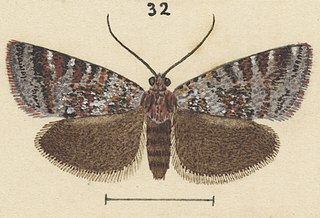
Tortrix incendiaria is a species of moth of the family Tortricidae. It is endemic to New Zealand. It is likely that this species probably belongs to another genus and as such this species is also known as Tortrix (s.l.) incendiaria.

Tortrix fervida is a species of moth of the family Tortricidae. It is endemic to New Zealand. It is likely that this species probably belongs to another genus and as such this species is also known as Tortrix (s.l.) fervida.




















